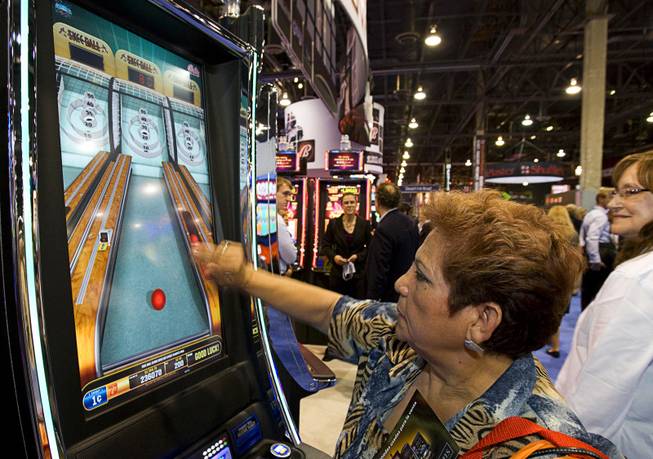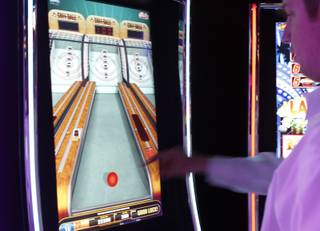
Yolanda Vales of Saratoga, Calif., tries out a Skee-Ball bonus game on a Bally Technologies video slot machine during the first day of the Global Gaming Expo (G2E) convention at the Sands Expo Center Tuesday, Oct. 4, 2011.
Monday, April 2, 2012 | 2 a.m.
Bill Wadleigh remembered how much he loved playing Skee-Ball as a boy in the arcades of New Hamphire and how disappointed he was with the cheap sunglasses he received in return for the tickets he won.
Now, as the head of design for Bally Technologies in Las Vegas, Wadleigh has turned those cut-rate prizes into casino cash. Using touch screens and leader boards, Wadleigh's new wave of gaming systems play like arcade games and pay like slot machines. Such games as Skee-Ball and Total Blast — a starship shooting game reminiscent of the old Space Invaders — could be showing up on casino floors by summer.
"It's 100 percent legal, and 100 percent fair," Wadleigh said.
Bally introduced the games at the Global Gaming Expo this past fall, and the systems are now in testing labs to ensure they comply with casino laws in dozens of different states and countries.
The games caught the attention of the gaming industry. Skee-Ball and Total Blast helped Bally grab five of the top 10 places last week in Casino Enterprise Management's sixth annual rankings of the most innovative slot floor technologies.
But video games use skill, and Nevada gambling laws require electronic casino games to have an element of chance. Wadleigh and his development team of graphic artists, engineers and mathematicians have found a way to combine skill thrills of video games with the random hits of the slots.
Wadleigh showed up at Bally three years ago after jumping from television production into designing video games with Microsoft, Hasbro and AOL. Making one video game at his former workplaces, he remembered, would take hundreds of people working 14-hour days, seven days a week for three to five years.
The interactive slots developed at Bally require a team of four and takes eight months.
"We work typical 45-hour weeks, and my family can expect me home for dinner most nights," Wadleigh said. "The scope of these projects is much tidier."
Still, slot technologies are built from scratch.
"You can't use traditional video game technologies, because it's not like these games run on Microsoft Windows," he said.
The games actually work on a proprietary Linux-based system. Bally had to build an engine that would handle real-time 3D graphics that could emulate a real Skee-Ball arcade game.
Instead of pulling a handle or punching a button, players use the touch screen to flick virtual balls down the lane, up the ramp and into the target holes, as a scoreboard rings up their points. The game even awards animated ticket rolls, just like the real arcade game.
That's the skill part. Here's where the chance comes in.
Players take those virtual tickets to shelves of prizes. They can pick a drawing of a kazoo, a yo-yo and other toys they might find in an arcade. When they touch the prize, it registers how many points that prize is worth, and how much money the players win.
There are 200 possible numbers on each shelf and some two dozen prizes total. The more tickets a player earns, the better the prize on the screen. But that doesn't mean the player with more tickets earns more money. Through randomly generated numbers, a player with one ticket could pick a prize on the bottom shelf that wins more money than the prizes on the top shelf. Players don't know how many credits their prize is worth until after they select it.
What's with the points?
It gives the players a chance to add their names to leader boards, as they would with any video game.
"By doing it this way you still get bragging rights for high scores, but it doesn't take away the games of chance," Wadleigh said.
Who comes up with these ideas?
Wadleigh's Live Wires Team at Bally consists of engineer Alex Shatsky, artist Kevin Reasbeck, and media tech/3D artist Travis Fields. Bally's audio, mathematics and testing department help put the games together.
The games have to be simple to follow and operate, in addition to being entertaining.
"Let's be realistic, people are drinking alcohol with these," he said. "You want people to stay at one machine. The first time it gets too complicated, they're going to move."
There's a big advantage in designing slots over video games, Wadleigh said. He gets to see players' reactions. People generally play online games, computer games and video games at home. But Wadleigh can — and often does — walk into a Vegas casino, stand at a distance and watch people play the games he's helped develop.
"You can just watch see their reactions that they either love it or hate it," he said. "They either will love it or hate it. They're passionate about these games, and they show it. It's what's great about this job. I love coming into work every day."


Join the Discussion:
Check this out for a full explanation of our conversion to the LiveFyre commenting system and instructions on how to sign up for an account.
Full comments policy